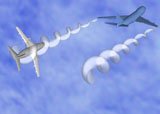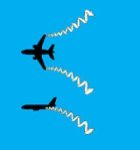Wake Turbulence
As your aircraft is on approach, you suddenly feel it start to roll and it's a relatively calm day. What is it? It can be wake turbulence. While wake turbulence can happen during all phases of your flight, it most happens on approaches and takeoffs.
It is generated during flight when the wing develops lift. Air spills over the wingtips from the high pressure areas below the wings to the low pressure areas above them. This flow causes counter-rotating trailing vortices that are usually invisible. The intensity of these vortices depend on the aircraft weight, speed, wingspan, and landing (in our case) or takeoff configuration. When the aircraft is a "heavy" (such as a B747), slow, in a clean configuration, and operating at a high angle of attack (nose of aircraft is pointed at a high angle but is not climbing, but rather staying level or descending) it is generating the strongest vortices.
Wake turbulence always descends below and behind the generating aircraft. To avoid this, pilots and air traffic controllers do a couple of things. First, on approach and takeoff, the pilots will try to stay above the glide path of the preceding aircraft. Secondly, your pilots and air traffic controllers will maintain minimum separation distances depending on the weight of the preceding aircraft. For example, if the aircraft landing before you is a "heavy", then 4 to 5 mile separation is sought.
With a large mix of heavy and smaller aircraft approaching or taking off, flights can be potentially delayed a bit to accommodate these safe separation distances. For example, the new A380 (Airbus 380) that has just started flying is in a new category - "Super". What this means is that trailing aircraft must have at least 5 miles separation while in enroute and in the terminal area - 10, 8, and 6 mile trailing separation for small, large, and heavy aircraft respectively.



Wake Turbulence Vortices
Wake Turbulence Vortices
Wake Turbulence Vortices
Wake Turbulence back to My Airline Flight